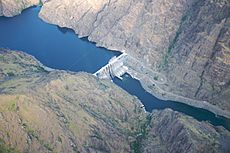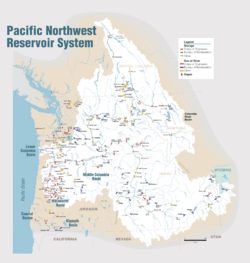Hells Canyon Dam facts for kids
Quick facts for kids Hells Canyon Dam |
|
|---|---|

Aerial view of the dam
|
|
| Location | Hells Canyon, Adams County, Idaho / Wallowa County, Oregon United States |
| Coordinates | 45°14′41″N 116°41′54″W / 45.24472°N 116.69833°W |
| Opening date | 1967 |
| Operator(s) | Idaho Power Company |
| Dam and spillways | |
| Impounds | Snake River |
| Height | 330 ft (100 m) |
| Reservoir | |
| Creates | Hells Canyon Reservoir |
| Total capacity | 188,000 acre⋅ft (232,000,000 m3) |
| Catchment area | 73,300 sq mi (189,800 km2) |
| Surface area | 3.9 sq mi (10 km2) |
| Power station | |
| Installed capacity | 391 MW |
| Annual generation | 2,051.3 GWh |
The Hells Canyon Dam is a large concrete dam located in the western United States. It sits on the Snake River in a deep canyon called Hells Canyon. This area is right on the border between Idaho and Oregon.
The dam creates a lake behind it called Hells Canyon Reservoir. It is an important part of a group of dams that produce electricity for people.
Contents
About the Hells Canyon Project
The Hells Canyon Dam is the third and last dam built as part of the Hells Canyon Project. This project also includes two other dams: Brownlee Dam (built in 1959) and Oxbow Dam (built in 1961). All three dams were built and are run by the Idaho Power Company.
Together, these dams form the largest privately owned hydroelectric power system in the United States. This means they are owned by a company, not the government, and they use water to make electricity. The company that built Hells Canyon Dam was Morrison-Knudsen from Boise, Idaho.
How the Dam Makes Power
The Hells Canyon Dam has a special building called a powerhouse. Inside, there are three large machines that generate electricity. These machines can produce a total of 391 megawatts (MW) of power.
The first two power-generating units started working in 1967. The third unit was added the next year, in 1968.
Impact on Fish Migration
The three dams of the Hells Canyon Project do not have a way for fish to pass through them. This means that salmon and other fish that travel upstream from the ocean (called anadromous fish) cannot get past the dams.
These dams block a long stretch of the Snake River. Fish cannot reach the upper parts of the river basin where they used to lay their eggs. This blockage goes all the way up to Shoshone Falls, which is a natural waterfall that already stops fish from going further upstream.
Original High Dam Plan
The Hells Canyon Dam that was built is much smaller than what was first planned in the 1940s. The original idea was to build one very tall dam, about 710 feet high. Instead, three smaller dams (Hells Canyon, Brownlee, and Oxbow) were built.
The United States Army Corps of Engineers first suggested the "Hells Canyon High Dam." It would have been a straight concrete dam with two tunnels for water to spill out. The lake behind this huge dam would have been very large, covering about 23,500 acres and stretching 89 miles upstream.
This proposed dam was designed to make a lot of electricity, about 850 MW, using ten power units. The plan also included special fish hatcheries to help salmon populations. However, this very large single dam project was never built.
Images for kids



